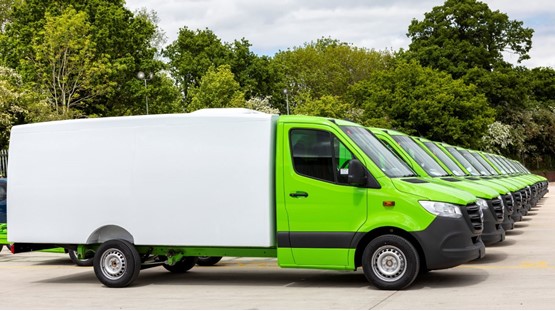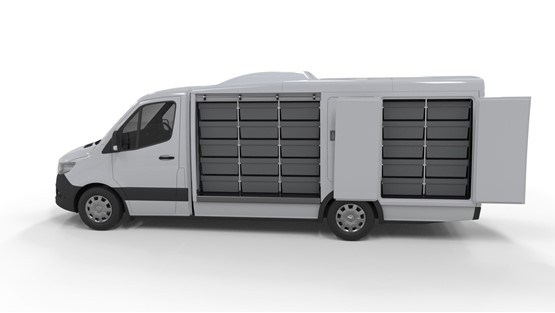
British engineering firm Penso has developed a new ultra-lightweight carbon fibre body for 3.5-tonne vans, offering a payload advantage of up to 50%.
Designed to tackle the issues facing last mile logistics fleets, the Blue Ocean Home Delivery Pods are built on a Mercedes-Benz Sprinter chassis.
By extending the body length and decreasing weight, Penso has increased available cargo space by 30% when compared to an equivalent body.
Fuel economy is also improved by up to 30%, as a result of better aerodynamics.
For fleets looking to switch to electric, the conversion is also compatible with the electric Sprinter.
Daniel Hurcombe, manging director of Penso, said: “We have taken an entirely fresh approach in what is typically a very traditional sector, using new materials and processes to unlock major efficiency and sustainability improvements for last mile delivery.
“Crucially, we can offer customers a clear road map to net zero emissions and dramatic improvements in total cost of ownership.”
The first Blue Ocean model is a triple compartment temperature-controlled pod for grocery home deliveries, offering the ability to carry 140 totes versus the industry standard of 110 to 120.
Penso can adapt bodywork configurations for different customers, with the launch vehicle holding 72 ambient totes, 45 chilled totes and 23 frozen totes.
This model boosts payload capacity by 47% to 1,250kg versus an average of 850kg for a traditional 3.5-tonner in this sector.
Real-world testing returned a fuel economy improvement of 10mpg, when compared to an existing customer vehicle.
Hurcombe said: “For a typical supermarket vehicle, that equates to a saving of around £2,400 per vehicle per year in diesel costs alone. Multiply that across a fleet of 3,000 home delivery vans and suddenly you’re saving £7,200,000 a year on diesel. That’s a fairly compelling saving for a fleet manager to share with their finance and procurement teams.”

The second Blue Ocean model will enter production in July 2020 and is an ultra-lightweight Luton van, offering 19 cubic metres of load space and an interior height clearance of 2.4m.
It provides a payload capacity of 1,500kg, dependant on the customer’s final specification. Traditional bodies typically give a payload of 900–1,000kg in a similar application.
Ultimately, 30 different LCV body variants will be built across different wheelbases and vehicle platforms to suit a variety of applications and fleets.
Penso’s new facility is designed to build up to 10,000 vehicle bodies per year, and the company’s plan is to ramp up production steadily over the next five years to fill that capacity.
With a carbon fibre construction, the new vehicles have a higher upfront cost but Penso says the vehicles offer comparative wholelife costs.
Hurcombe said: “Creating a carbon fibre pod could be seen as an expensive exercise purely to reduce weight; but developing the commercial and operational model alongside the design, engineering and manufacturing process has been just as important. In fact, it’s the commercial and market demand to reduce weight which drove the solution.
“Home delivery fleets face multiple challenges, including how they reduce their carbon footprint, cope with driver shortages and increase the number of delivery slots they can offer in a market faced with increasing legislation and the imminent technology change away from diesel. What we’ve done at Penso is create a solution which can deliver tangible benefits in all of these areas.”
Each conversion comes with a 10-year structural warranty, which means fleets can plan around each pod lasting twice as long as a traditional body in a high-utilisation, frontline fleet. In most applications this will mean transferring the pod onto a new chassis after five years.
Penso has geared its operation to be able to undertake the body swap on behalf of customers.
“We’ve worked closely with funders on our financial modelling and we are confident the financing and depreciation costs of the pod over 10 years are, at worst, the same as traditional technology. And in many ways they are less expensive, given a regular body would normally need replacing after five years,” Hurcombe added.





















Login to comment
Comments
No comments have been made yet.